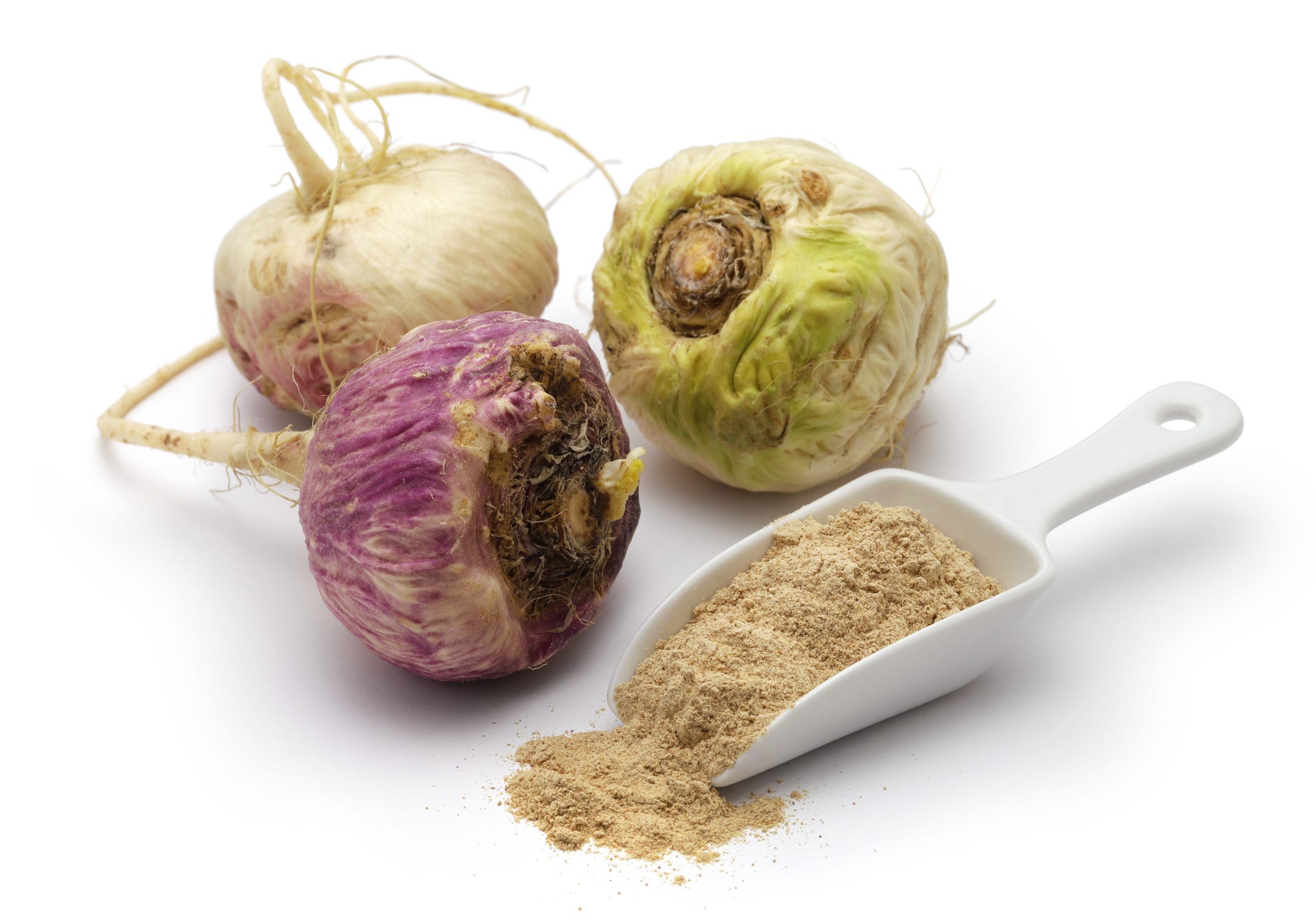
Ancient Food, Nourishing Medicine
Maca (Lepidium meyenii) has been cultivated as a food and medicine in the Peruvian Andes mountains for more than 3000 years. A resilient member of the brassica (mustard) family, maca thrives at an elevation of 15,700 feet in a harsh dry climate, where temperatures do not exceed 12°C (53°F). Resembling a radish, this tuberous vegetable grows to an average height of only four-to-eight inches. Its tubers (aka hypocotyl) vary in color from black to red, to yellow, depending on the content of flavonoids (carotenoids and anthocyanins) in the outer skin. Yellow maca is the preferred variety for its sweeter taste.
Maca is indigenous to Peru and is highly valued as a subsistence food as well as an herbal commodity. Andean people consume more than an average of 100 g maca root daily. Fresh maca root is not consumed due to potential adverse effects. Maca is traditionally baked in underground pits, boiled, and eaten as porridge, fermented drinks, and empanadas. Considered a ‘natural genetic heritage product of Peru’, farmers have been selecting the best traits and saving seed stock over centuries.
Like sweet potatoes, maca is considered a low calorie, energy dense food abundant in starchy carbohydrates. Similar to other root vegetables, maca is packed with a diverse array of minerals including potassium, calcium, magnesium, iron, zinc, manganese and copper. It is particularly high in protein, fiber, calcium, iron, and vitamin C. Considered to be among the oldest cultivated food plants, roasted maca smells and tastes a bit like caramel. Not bad for a brassica!
Maca’s Roots Run Deep
Maca has been traditionally used in Peru as a food and medicine for a variety of purposes, including improving energy, stamina, sexual dysfunction. The Incas considered maca to be a sacred plant and used it for its energizing and medicinal properties. Inca warriors were fed maca for strength and resilience in battle. But it wasn’t until 1653 that Father Cobo first described maca’s fertility-enhancing properties. Maca root was fed to livestock to counter the fertility-decreasing effects of high altitudes. In 1964, maca was reported to be used by Indian and white women hoping to bear children and as a tonic for postmenopausal women.
For the last 20 years, maca has gained popularity as a supplement for reproductive health, particularly for improving sexual function, fertility, and hormonal balance. Maca has been commercially promoted as a super food, as “Peruvian viagra’ and “Peruvian ginseng’ referring to its attributed health claims of increasing vitality, enhancing fertility and libido, as well as alleviating menopausal symptoms in women.
Maca Madness – Protecting Peruvian People & Fighting Biopiracy
Today, the Netherlands, USA, UK, Canada, China, Germany, and Japan are the chief consumer countries of maca based products. This has put maca in high demand leading to concerns about its sustainability. Maca producers are under immense pressure to meet growing demands and compromise the traditional farming methods used to produce high quality Peruvian maca. Not only are maca farmers decreasing the timeframe for maca-grown soils to rest fallow from ten years to five, but they also began using to artificially boost commercial yields of maca root. Maca root is a slow-growing crop that is vulnerable to disease, and its cultivation can be challenging in the high-altitude Andean region. As a result, there are concerns about overharvesting and unsustainable farming practices, which could have negative impacts on the environment and the communities that rely on maca for their livelihoods.
Moreover, in the late 1990s, the demand for maca increased drastically. Especially black maca. This is directly tied to Traditional Chinese Medicine (TCM) system which associates maca, especially black maca, with the kidneys, an organ system that stores Jing (or life essence) as well as Chi (energy). The function of the kidneys is lost with age, is not able to be recovered, and must therefore be nourished and protected, especially as we age. This led to the beginning of China’s biopiracy practices which began in 2002 after viable maca seeds were taken from Peru to implement large-scale cultivation in China’s highland provinces to supply maca to its own country as well as exporting it commercially as an herbal commodity. Biopiracy refers to the exploitation of traditional knowledge or biological resources without permission or compensation to the communities or countries that developed or preserved them.
Peruvian Maca is Precious and Preferred
There continues to be growing concerns about maca and biopiracy. There have been instances where some companies have sought to patent maca-related products and technologies without proper recognition or compensation for the indigenous communities that have traditionally used and cultivated the crop. In some cases, this has led to legal disputes and tensions between countries.
To address these issues, there are efforts underway to promote sustainable and fair-trade practices for maca root. For example, some organizations are working to support fair trade certification for maca farmers, which would ensure that they receive fair compensation for their crops and that the production of maca is environmentally sustainable. Additionally, there are efforts to promote the cultivation and preservation of maca by indigenous communities, which could help to protect traditional knowledge and practices while supporting local economies.
Overall, there is a need for careful monitoring and management of the commercial production and trade of maca, to ensure that the crop remains a sustainable and culturally significant part of the Andean highland communities, while also meeting the growing global demand for maca-based products.
Peruvian vs. Chinese-Grown Maca, Is There a Difference in Quality?
There is limited research comparing the quality, phytochemical potency, and nutrient value of Peruvian-grown maca and Chinese-grown maca. However, some studies have suggested that there may be differences between the two, particularly in terms of their chemical composition and biological activity.
One study compared the chemical composition and antioxidant activity of four different varieties of maca, including two from Peru and two from China. The researchers found that the Peruvian maca varieties had higher levels of certain bioactive compounds, including polyphenols and flavonoids, and greater antioxidant activity compared to the Chinese maca varieties.
Another study compared the nutrient content of Peruvian-grown maca to commercially available Chinese-grown maca powder. The researchers found that the Peruvian maca had higher levels of certain nutrients, including calcium, potassium, and iron, compared to the Chinese maca.
It's worth noting that the quality and potency of maca root can vary depending on factors such as the variety, growing conditions, and processing methods. Additionally, there is no standardized method for measuring the bioactive compounds in maca, which can make it difficult to compare different varieties or sources.
Overall, more research is needed to fully understand the differences between Peruvian-grown maca and Chinese-grown maca, as well as their potential health benefits and risks. When purchasing maca root or maca supplements, it's important to choose a reputable source that delivers organically grown Peruvian maca. Now that you are aware of the ongoing ecological and ethical concerns surrounding the production of maca root powder, it is time to explore its therapeutic potential via current scientific evidence.
Maca, a Nutritive Approach to Support Reproductive Health
Current allopathic treatments for sexual problems including low libido and erectile dysfunction, are associated with a variety of adverse effects. Since the 1990s, maca root has emerged as a natural, nutritive approach to improving sexual desire or libido. Guided by its traditional use to improve fertility and sexual health, modern research has shown promising results on the effectiveness of maca for supporting reproductive health. While the number of clinical trials is limited, studies have suggested that maca may help improve sperm quality and increase libido in men, as well as support menstruation and alleviate minor menopause symptoms in women.
Currently, no therapeutic drugs exist to improve sperm quality in men. Research has shown that maca root may have a positive impact on sperm health in men. In a study published in the journal Andrologia, researchers found that after 12 weeks, men who took maca supplements experienced a significant increase in sperm motility and semen volume. Another study published in the Asian Journal of Andrology found that maca supplementation improved sperm count and motility in adult men with low sperm count. A 2010 systematic review of four clinical studies concluded that maca supports erectile function and improved other types of sexual dysfunction in men and women.
Research on maca's effects on women's reproductive health is still limited, but some studies have suggested that it may have a positive impact. A randomized, double-blind, placebo-controlled trial published in the journal Menopause found that women who took maca supplements, for at least six weeks, experienced significant improvements in sexual function, including increased desire and decreased sexual dysfunction, compared to those who took a placebo. Another study published in the Journal of Evidence-Based Complementary and Alternative Medicine found that women who took maca supplements experienced increases in sexual desire compared to those who took a placebo. Additionally, a 2016 study published in the Journal of Pharmaceuticals found that women who took maca root for 12 weeks experienced benefits to menstrual regularity and conception rates.
While these studies suggest that maca root may have potential benefits for reproductive health, it's important to note that many of them are small and more research is needed to fully understand the effects of maca on fertility and sexual function. Additionally, the optimal dosage and duration of maca supplementation for these purposes are not well-established. Anyone considering using maca root for reproductive health should speak with a healthcare professional first.
Maca’s Mechanism of Action is Multifaceted
More research is needed to fully understand how maca root affects the body and its reproductive processes. The exact mechanism of action for maca's effects on reproductive health is not fully understood and is likely complex and multifaceted. However, it is believed that maca's high levels of antioxidants and phytonutrients may help reduce oxidative stress and inflammation, which can contribute to reproductive health issues. Some of the proposed mechanisms of action for maca root may differ between men and women. Here are some possible mechanisms:
For men:
Supports testosterone levels: Maca root has been shown to support health increases in testosterone levels in men, which may lead to improved fertility, sexual function, and muscle mass.
Supports sperm production and motility: Maca root has been shown to improve sperm production and motility in men, which may support fertility.
Support prostate health: with human trials still pending, animal studies have suggested that maca root (especially red maca) may maintain normal prostate size in men, which could be beneficial for conditions such as benign prostatic hyperplasia (BPH).
For women:
Improved hormone balance: Maca root may help to balance hormone levels in women, particularly estrogen and progesterone. This may help to regulate the menstrual cycle and support fertility.
Increased libido: Maca root has been shown to increase sexual desire in women, which may be related to its effects on hormone balance.
Reduced symptoms of menopause: Some studies have suggested that maca root may s upport a woman's body through menopause, giving targeted support during hot flashes and mood swings by helping hormone levels.
Maca’s Bioactive Compounds
Overall, maca root is a nutrient-dense food that contains a variety of important macro and micronutrients as well as bioactive compounds that may have potential health benefits. Maca’s bioactive compounds include β-carboline alkaloids, glucosinolates, common amide alkaloids, macamides, and imidazole alkaloids. More research is needed to fully understand the effects of these compounds on human health, but here is what we know so far:
- Flavonoids: Maca root contains several types of flavonoids, which are plant pigments that have antioxidant properties and are believed to have a variety of health benefits. These compounds are known for their antioxidant and neuroprotective effects.
- Black maca has the highest concentration of flavonoids, red maca has moderate amounts and yellow maca has the least.
- Animal studies reveal that red maca and to a lesser extent yellow maca can support the prostate, but not black maca.
- Black maca, but not red or yellow, appears to have a positive effect on daily sperm production.
- Glucosinolates: all varieties of maca root are rich in glucosinolates, sulfur-containing compounds that have been linked to potential health benefits such as reducing inflammation. Benzyl glucosinolate has been specifically studied for its prostate-supporting properties.
- Alkaloids: Macaridines, macamides, imidazole alkaloids, β-carboline alkaloids, and common amide alkaloids are the five chief alkaloids present in maca, which are believed to have a variety of health benefits, including improving fertility, reducing inflammation, and enhancing cognitive function.
- Macamides and macaenes are thought to be responsible for the majority of maca’s therapeutic effects. These phytochemicals have been shown to have adaptogenic, antioxidant, and inflammation modulating properties, making maca a potentially useful supplement for a variety of health conditions.
- Maca’s macamides have been the focus of several studies on maca's effects on sexual function and fertility. Macamides have been shown to stimulate the production of neurotransmitters in the brain that are involved in sexual arousal and desire, as well as to support sperm motility and sperm count.
- In addition to their effects on sexual function and fertility, β-carboline alkaloids have also been shown to have other potential health benefits. For example, some studies suggest that they may have anti-inflammatory and antioxidant properties.
- Safety and Dosage Recommendations
Maca is generally considered safe and well-tolerated, but as with any supplement, it is important to follow recommended dosage guidelines. Most clinical trials have found that improvements in libido, as well as a reduction in minor postmenopausal symptoms, occur after using maca regularly for at least 6 weeks. For erectile support, maca was found to be effective after regular use for at least 12 weeks.
The optimal dosage of maca may vary depending on the individual and their specific health needs. At PRL, our Peruvian, organically grown maca is part of our thoughtfully formulated products including Radiant Woman, and Men’s Performance Edge, where it is synergistically blended with other botanicals and nutrients. When using maca root powder alone, a typical dosage is 1-3 teaspoons per day, which can be added to smoothies, baked goods, or other foods. It is important to choose high-quality Peruvian-grown maca products from reputable, fair-trade sources to ensure safety, purity, ethics, and efficacy.
Integrating maca into a balanced and nutrient-dense diet, along with regular exercise and other healthy lifestyle habits, may offer benefits for reproductive health. By staying informed on the latest research and using high-quality, ethically sourced maca products, wellness practitioners and nutritionists can help support their clients' reproductive health and overall well-being.
Not All Maca Products are Created Equal
The quality and potency of maca can vary depending on a variety of factors, such as growing conditions and processing methods. One key difference in maca products is their nutrient content and phytochemical potency. For example, Peruvian-grown maca has been shown to have higher levels of certain nutrients, such as calcium and iron, compared to Chinese-grown maca. Additionally, the phytochemical potency of maca can vary depending on factors such as the color of the root, with darker roots generally having higher levels of bioactive compounds.
In addition to nutrient content and phytochemical potency, there are several other factors that can affect the quality of maca products. For example, the way that maca is grown and processed can impact its overall quality. Maca that is grown organically and processed using gentle methods, such as low-temperature drying, may retain more of its nutrients and phytochemicals compared to maca that is conventionally grown and processed using high-heat methods. Other factors that can affect the quality of maca include the age of the root, the storage conditions, and the packaging.
To ensure that you are getting a high-quality Peruvian-grown maca product, it's important to do your research and choose a reputable supplier. Look for maca products that are Fair Trade-certified and sourced from organic, sustainable farms, and that are processed using gentle methods. Consider the color of the maca root, as darker roots may indicate higher levels of bioactive compounds. Finally, check the packaging to make sure that the maca product has been stored properly and is not past its expiration date. By choosing high-quality maca products, you can be confident that you are getting the most nutrient-dense and potent form of this beneficial plant.
QRA-Inspired Tips for Additional Reproductive Support
In addition to recommending maca for reproductive health, wellness practitioners can support their clients' overall well-being and reproductive health by implementing a holistic treatment protocol informed by the practices and philosophy of QRA.
QRA treatment philosophy emphasizes the importance of balancing the body's energy meridians, which can promote healing and optimal functioning. One way to support reproductive health is to address imbalances in the pelvic region, such as misalignments in the spine or suboptimal nutrient status. By using QRA testing methods, practitioners can identify and address these imbalances through targeted nutritional support, chiropractic adjustments, and other modalities.
Additionally, practitioners can educate their clients about the importance of lifestyle factors such as stress management, sleep hygiene, and healthy diet and exercise habits. By taking a holistic approach to reproductive health and addressing the root causes of imbalances, wellness practitioners can support their clients' health and well-being in a comprehensive way.
Maca Provides Mood-Modifying Reproductive Health Support
In summary, maca is a root vegetable with a long history of use in traditional medicine, and recent research has shown promising results for its use in reproductive health. Maca's nutrient content and phytochemical properties vary based on the variety and growing conditions, and it's crucial to choose high-quality products to ensure the best results. However, the increasing demand for maca worldwide has led to environmental concerns and issues with biopiracy and intellectual property rights.
As wellness practitioners and nutritionists, it's essential to prioritize ethical sourcing and sustainability practices when recommending maca-based products to clients. We can support sustainable and fair-trade practices that protect the environment, respect the rights of indigenous communities, and promote the health and well-being of all involved in the supply chain.
In conclusion, by educating ourselves and our clients about the benefits and risks of maca and supporting sustainable and ethical sourcing practices, we can promote both health and environmental stewardship. Let's work together to create a world where the production and consumption of health-promoting products aligns with our values and contributes to a better future for all.
References
- Beharry, Shruti and Heinrich Michael. Is the hype around the reproductive health claims of maca justified? Journal of Ethnopharmacology. 2018 Jan 30;211:126-170. doi: 10.1016/j.jep.2017.08.003. https://core.ac.uk/download/pdf/111078402.pdf
- Smith, Tyler. Maca Madness: Chinese herb smugglers create chaos in the Peruvian Andes; Consequences for the market, consumers, and local farming communities. Herbalgram, Issue #105, pgs 46-55. https://www.herbalgram.org/resources/herbalgram/issues/105/table-of-contents/hg105-feat-maca/
- Shin BC, et al. Maca (L. meyenii) for improving sexual function: a systematic review. BMC Complementary and Alternative Medicine 2010, 10:44 http://www.biomedcentral.com/1472-6882/10/4
- Baldermann, S. et al. 2016. Are neglected plants the food for the future? Critical Reviews in Plant Sciences, 35:2, 106-119, DOI: 10.1080/07352689.2016.1201399
- Jagdale YD, et al. Nutritional profile and potential health benefits of super foods: a Review. Sustainability 2021, 13, 9240. https://doi.org/10.3390/su13169240 https://www.mdpi.com/journal/sustainab
FAQ
Q: What is Maca and what are its benefits?
A: Maca is a root vegetable that grows in the Andes mountains of Peru. It has been used for centuries as a natural remedy for a variety of health concerns, including energy, libido, and reproductive health. Maca is also high in antioxidants and nutrients like vitamin C, copper, and iron.
Q: How does Maca work?
A: Maca works by stimulating the body's endocrine system, which controls hormone production. It has been shown to increase levels of luteinizing hormone (LH), which is responsible for regulating testosterone in men and estrogen in women. This can lead to improved energy, mood, and sexual function.
Q: How should I take Maca?
A: Maca can be taken in several forms, including capsules, powders, and extracts. It is generally recommended to start with a low dose and gradually increase over time. The recommended daily dosage of maca root powder is typically between 1.5 and 5 grams per day.
Q: Are there any side effects of taking Maca?
A: Maca is generally considered safe for most people. However, some people may experience mild side effects such as stomach upset, headaches, or changes in menstrual cycles. It is important to talk to your healthcare provider before taking maca, especially if you are pregnant, breastfeeding, or have a history of hormone-sensitive conditions.
Q: Can Maca help with fertility?
A: Maca has been traditionally used as a natural fertility treatment. It may help improve sperm count, motility, and quality in men, and regulate menstrual cycles and promote ovulation in women. However, more research is needed to determine its effectiveness in treating fertility issues.









